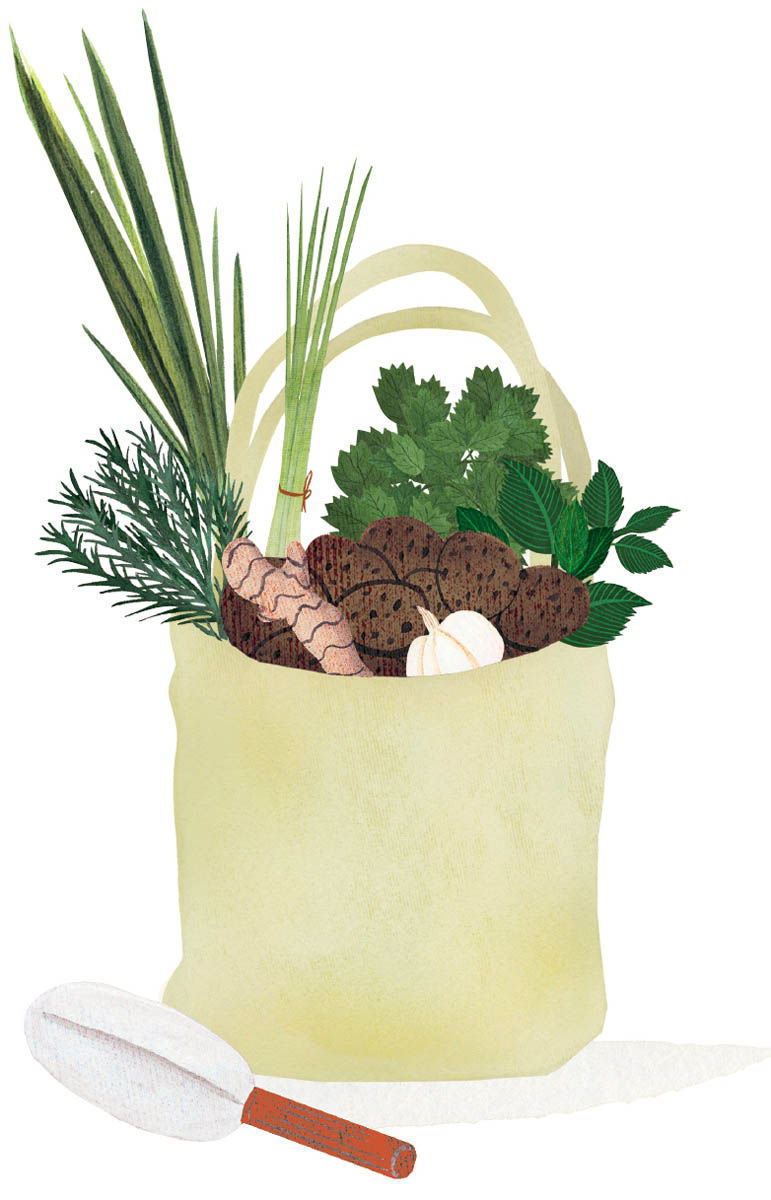
Jenks Farmer wants you to know that you can easily, quickly, and inexpensively grow food from what you buy at the grocery store. “Many vegetables and fruits have seeds, roots, and shoots that can be used to grow more plants just like them!” he says. In his own yard, Jenks has created an edible oasis in which the majority of the plants have come from regrowing or propagating food that comes from the supermarket.
Jenks’s inspiration for a grocery garden came from his travels. “When traveling and living in other countries, I would see things in markets that fascinated me,” Jenks recalls. “I remember once in Cambodia buying a tiny, tiny round eggplant at the market, and from it, I got about a dozen seeds and planted them at my friend’s house.” Since then, he’s experimented with many vegetables and fruits from grocery stores and farmers’ markets, trying to sprout seeds and root anything that comes with a stem.
A beautiful combination. A couple of Jenks’s favorite grocery-store goodies are flax and elephant garlic (not a true garlic but a cousin that is closely related to leeks). In the fall, he simply divides the garlic head into bulbs and pushes them into the soil, leaving a tiny bit of the tip exposed. Then he sprinkles the top with flax seeds and covers them with another quarter-inch of soil.

To grow bulbous stem crops like leeks and lemongrass, Jenks advises looking at the base of the plant. “Leeks will almost always have a basal plate, which is the bottom of a bulb where the roots initiate,” he says. The basal plate on lemongrass has often been removed before it is displayed in the supermarket, so you may need to dig to find one that has a little bit of base and, if possible, a few roots. For peanuts, you’ll need to find a supplier with uncooked pods. They don’t have to be organic, Jenks says, but he tries to find organic peanuts.
Where to shop. The best places to source vegetables and fruits to root or plant are a local organic grocery store, the organic section of a large supermarket, or an ethnic grocer. Jenks finds that small, organic stores tend to have the best stock of vegetables and fruits ready for planting, since they don’t have the overly meticulous expectations of perfection that some giant chains do. Jenks lives and gardens in Zone 8b, but those in cooler regions can also employ many of his methods, and grow the more tender specimens in pots and move them indoors for winter.
It’s not about quantity. Growing a grocery garden may not be the best way to produce large quantities of food — planting the basal plate of a leek or a stalk of lemongrass will yield a single plant, for example, though peanuts or beans can yield a much larger harvest when planted in quantity — but that isn’t Jenks’s goal. “It’s not about a meal; it’s about making connections, and it’s a story for the garden to tell,” he says. “It’s also a reminder that plants are food and food can become plants.”

With a little creative thinking, it’s amazing what you can do with the leftover bits of vegetables and herbs bought at the supermarket. That last sprig of mint? Root it! A handful of dried beans? Plant them! The stem end of a leek? Grow it!
Flax. Direct-seed in the garden or in pots alongside elephant garlic.
Elephant garlic. Best bought in the organic produce aisle.
Beans. A summer crop that is direct sown in late spring. “Lima beans from the grocery store usually make vines, but lots of beans grow on bushes,” Jenks says.
Jicama. With this native Mexican vine, Jenks says to look for a tuber with a bit of green on the top (avoid polished ones), and grow it on the fence in summer.
Peanuts. Plant uncooked, natural peanuts in a sunny spot.
Potatoes. In later winter, plant organic potatoes bought at the grocery store.
Mints. Grocery-store spearmint or other mint roots easily and can be planted in a garden or a pot. Just remember, it can be extremely invasive, so give it an isolated spot.
Ginger. Look for plump roots with well-developed “eyes.”
Leeks. Plant the rooted basal plate.
Rosemary. “If you get a young, fresh bunch from the grocery store, you can root them [the stems] in water,” says Jenks.
Lemongrass. Plant the rooted basal plate.
Papaya. Save the seeds from a fruit and start them inside. “Harvest the fruits when green for green papaya salad!” Jenks suggests.
Chrysanthemums. Jenks advises buying potted mums or cut flowers from the florist section, rooting them, and using the dried flower petals for tea.
Citrus. Jenks suggests trying to grow citrus plants from seeds. “They’re easy to grow, and I just let the seeds dry a few days, before planting them.”